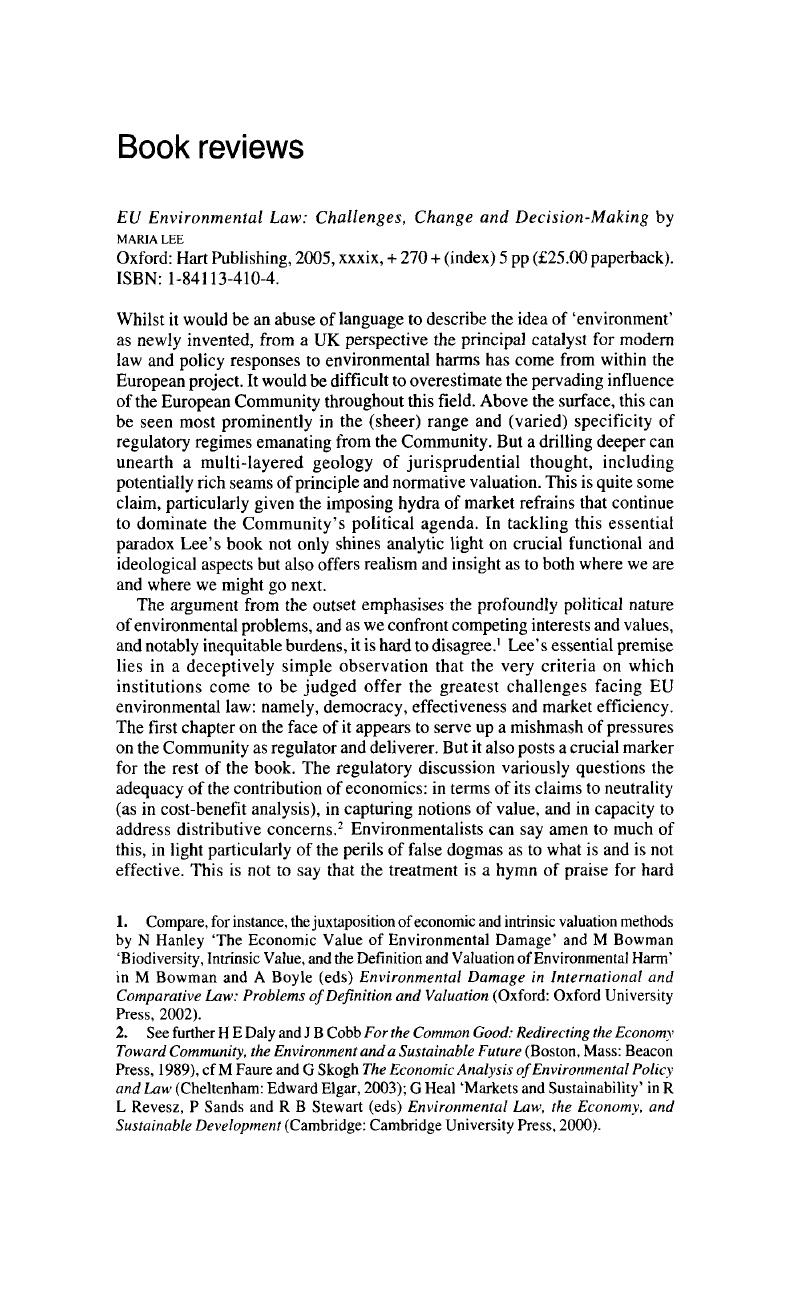No CrossRef data available.
Article contents
EU Environmental Law: Challenges, Change and Decision-Making by Maria Lee, Oxford: Hart Publishing, 2005, xxxix, + 270 + (index) 5 pp (£25.00 paperback). ISBN 1-84113-410-4
Published online by Cambridge University Press: 02 January 2018
Abstract

- Type
- Book Review
- Information
- Copyright
- Copyright © Society of Legal Scholars 2005
References
1. Compare, for instance, the juxtaposition of economic and intrinsic valuation methods by N Hanley ‘The Economic Value of Environmental Damage’ and M Bowman ‘Biodiversity, Intrinsic Value, and the Definition and Valuation of Environmental Harm’ in M Bowman and A Boyle (eds) Environmental Damage in International and Comparative Law: Problems of Definition and Valuation (Oxford: Oxford University Press, 2002).
2. See further H E Daly and J B Cobb For the Common Good: Redirecting the Economy Toward Community, the Environmentanda Sustainable Future (Boston, Mass: Beacon Press, 1989), cf M Faure and G Skogh The Economic Analysis ofEnvironmenta1 Policy and Law (Cheltenham: Edward Elgar, 2003); G Heal ‘Markets and Sustainability’ in R L Revesz, P Sands and R B Stewart (eds) Environmental Law, the Economy, and Sustainable Development (Cambridge: Cambridge University Press, 2000).
3. See N de Sadeleer Environmental Principles: from Political Slogans to Legal Rules (Oxford: Oxford University Press, 2003).
4. D A Farber Eco-pragmatism: Making Sensible Environmental Decisions in an Uncertain World (Chicago: University of Chicago Press, 1999).
5. M Lee and C Abbot ‘The Usual Suspects? Public Participation under the Aarhus Convention’ (2003) 61 MLR 80; J Steele ‘Participation and Deliberation in Environmental Law - Exploring a Problem-Solving Approach’ (2001) 21 OJLS 415; R Macrory ‘European Citizenship and the Law: Repairing the European Road’ (1996) 8 JEL 219.
6. R Macrory ‘Regulating in a Risky Environment’ [2001] CLP 619.
7. T Smith ‘Regulatory Reform in the USA and Europe’ (1996) 8 JEL 257.
8. S Barrett Environment & Statecraft: The Strategy of Environmental Treaty Making (Oxford: Oxford University Press, 2003).
9. Titanium Dioxide, Commission v Council [1991] ECR 2827.
10. For instance, M Jacobs ‘Sustainable Development as a Contested Concept’ in A Dobson (ed) Fairness and Futurity: Essays on Environmental Sustainability and Social Justice (Oxford: Oxford University Press, 1999).
11. See further A Ross ‘Is the Environment Getting Squeezed Out of Sustainable Development?’ [2003] PL 249.
12. J Holder Environmental Assessment - The Regulation of Decision Making (Oxford: Oxford University Press, 2004), especially pp 86-89.
13. See R B Stewart ‘A New Generation of Environmental Regulation?’ (2001) 29 Capital ULR 21 ; N Gunningham, P Grabosky and D Sinclair Sml? Regularion: Designing Environmental Policy (Oxford: Clarendon, 1998) pp 41-47; C R Sunstein ‘Paradoxes of the Regulatory State’ (1990) 57 U Chi LR 407.
14. Echoes of M Sagoff The Economy of the Earth: Philosophy Law and Economics (Cambridge: Cambridge University Press, 1988).
15. See D Adam ‘Global Companies Snub Survey on Climate Change’ Guardian, 15 September 2005.
16. See R C Paehlke Democracy’s Dilemma - Environment, Social Equity and the Global Economy (Cambridge, Mass: MIT Press, 2003).


